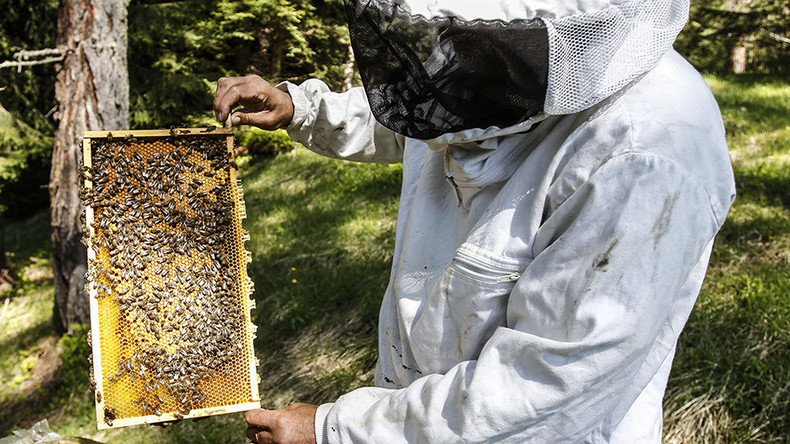EPA admits popular insecticide threatens honeybees

The US Environmental Protection Agency declared that one kind of neonicotinoid insecticide can be a threat to honeybees and some other pollinators. The announcement came as the EPA released its preliminary pollinator risk assessment for public comment.
Imidacloprid, one of the most widely used insecticides in the world, was originally produced by Bayer CropScience under the name Gaucho. It works on contact by interfering with the nervous system of insects, resulting in paralysis followed by death. It is much more toxic to insects and invertebrates because it binds better to their nerve cells receptors than it does to those of birds and mammals, according to the National Pesticide Information Center.
Neonicotinoids like imidacloprid were developed in the 1990s to boost yields of staple crops such as corn, but they are also widely used on annual and perennial plants in lawns and gardens. Researchers believe the neonicotinoids are causing some kind of unknown biological mechanism in bees that in turn leads to Colony Collapse Disorder (CCD), the disease killing off honeybees and threatening pollination of the world’s crops.
“EPA’s assessment, prepared in collaboration with California’s Department of Pesticide Regulation, indicates that imidacloprid potentially poses risk to hives when the pesticide comes in contact with certain crops that attract pollinators,” the agency said in a statement.
Imidacloprid affects hives at 25 parts per billion (ppb) and higher, the EPA found. The effects include decreases in the number of pollinators, as well as less honey produced.
Anti-pesticide groups point to current research blaming the cause of CCD on two popular types of neonicotinoids, including imidacloprid. Another study found that bees exposed to "field-realistic" doses of neonicotinoid insecticides gather less than half the pollen that they normally do, dooming their young to starvation. Such groups are calling on the EPA to join the European Commission in at least adopting a moratorium on such insecticides. In 2013, The EC adopted a two-year moratorium on the use of three neonicotinoid pesticides, including imidacloprid.
In 2015, the EPA proposed a prohibition on the use of pesticides that are toxic to bees, including the neonicotinoids, when crops are in bloom, and temporarily halted the approval of new outdoor neonicotinoid pesticide uses until new bee data is submitted and pollinator risk assessments are complete.
MAP: Bee colony loss by state http://t.co/hirpbJ8NAjpic.twitter.com/SXDxKGINQj
— Rebecca Beitsch (@RebeccaBeitsch) July 29, 2015
Honeybees pollinate more than 100 US crops, including apples, zucchinis, avocados and plums, that are worth more than $200 billion a year. CCD has killed tens of millions of honeybees in the US, with annual death rates of about 30 percent. Since 2006, about 10 million beehives at an average value of $200 each have been lost, according to a 2013 US Department of Agriculture Study. CCD is threatening the existence of those crops.
“EPA is committed not only to protecting bees and reversing bee loss, but for the first time assessing the health of the colony for the neonicotinoid pesticides,” said Jim Jones, the assistant administrator of the Office of Chemical Safety and Pollution Prevention. “Using science as our guide, this preliminary assessment reflects our collaboration with the State of California and Canada to assess the results of the most recent testing required by EPA.”
Canada’s Pest Management Regulatory Agency also released an Imidacloprid pollinator-only assessment on Wednesday, which reached the same preliminary conclusions as the EPA report. However, the Canadian agency noted that there was “no potential risk to bees,” from seed treated with imidacloprid, but that the effects from other application methods varied.
“The residue levels in crop pollen and nectar resulting from seed treatment uses are typically below levels expected to pose a risk to bees at both the individual bee and colony levels,” the PMRA said in a statement. The potential risk to bees for foliar applications “was indicated for bee attractive crops associated with pre-bloom, during-bloom, and some post-bloom applications, however, current label restrictions minimize potential risk.” Soil applications were the most likely to affect pollinators, the agency found, though it noted that the amount of risk depended on application rates and timing, soil type, and type of crop.
The EPA plans to conduct preliminary pollinator risk assessments on three other neonicotinoids ‒ clothianidin, thiamethoxam and dinotefuran ‒ which are scheduled to be released for public comment in December 2016. At the same time, the agency will also release a preliminary risk assessment of all ecological effects for imidacloprid, including a revised pollinator assessment and impacts on other species such as aquatic and terrestrial animals and plants.
The US agency has opened up a 60-day public comment period on its preliminary pollinator risk assessment for imidacloprid.
















